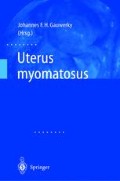Zusammenfassung
Das Auftreten von Verwachsungen ist eine häufige Folge nach praktisch allen operativen Eingriffen im Bauchraum. Die möglichen Auswirkungen reichen dabei von Schmerzen über Sterilität bis hin zum Ileus (diZerega 1994; Holtz 1984; Monk et al. 1994; Stone 1993). Die Entstehung von Adhäsionen ist direkt mit dem Heilungsprozess von Peritonealdefekten verbunden. Durch tierexperimentelle und klinische Studien konnte gezeigt werden, dass das viszerale Peritoneum (Uterus, Ovar, Tube und Darm) deutlich mehr von der Ausbildung von Verwachsungen betroffen ist als das parietale Peritoneum (Becken- oder Bauchwand; Larsson 1996; Korell 1994). Bei Eingriffen an den Adnexen bzw. am Uterus ist dementsprechend in bis zu 90% mit postoperativen Adhäsionen zu rechnen (diZerega 1994; Stone 1993). Besonders nach Myomenukleationen sind extrem häufig Verwachsungen zu beobachten. Dabei ist die Inzidenz von der Myomlokalisation abhängig. Während eine Uterotomie an der Vorderwand bei über der Hälfte der Frauen zu Adhäsionen führt, ist dies an der Hinterwand zu weit über 90% der Fall (Tulandi et al. 1993).
Access this chapter
Tax calculation will be finalised at checkout
Purchases are for personal use only
Preview
Unable to display preview. Download preview PDF.
Literatur
Beck DE (1997) The role of Seprafilm bioresorbable membrane in adhesion prevention. Eur J Surg 163: 49–55
Burns JW, Burgess L, Skinner K, Rose R, Colt MJ, Diamond MP (1996) A hyluronate based gel for the prevention of postsurgical adhesions: Evaluation in two animal species. Fertil Steril 66: 814–821
Delaco PA, Stefanetti M, Pressato D, Piana S, Dona M, Pavesio A, Bovicelli L (1998) A novel hyaluronan-based gel in laparoscopic adhesion prevention: preclinical evaluation in an animal model. Fertil Steril 69: 318–323
diZerega G (1994) Contemporary adhesion prevention. Fertil Steril 61: 219–235
Holtz G (1984) Prevention and management of peritoneal adhesions. Fertil Steril 41: 497 - 511
Hulka JF, Peterson HB, Phillips JM, Surrey MW (1993) Operative Laparoscopy. American Association of Gynecologic Laparoscopists 1991 Membership Survey. J Reprod Med 38 (8): 569–571
Interceed Adhesion Barrier Study Group (1989) Prevention of postsurgical adhesions by Interceed (TC7), an absorbable adhesion barrier: A prospective, randomized study. Fertil Steril 51: 933–938
Jansen RP (1988) Early laparoscopy after pelvic Operation to prevent adhesions: safety and effìcacy. Fertil Steril 49: 26–31
Korell M, Scheidel P, Hepp H (1994) An animal experimental model for adhesion reformation study. J Invest Surg 7: 409–415
Korell M (1996) Adhesion prophylaxis in gynecology. In: Treutner KH, Schumpelick V (eds) Peritoneal adhesions. Springer, Berlin Heidelberg New York Tokyo, 1996, pp 325–330
Larsson B (1996) Efficacy of Interceed in adhesion prevention in gynecologic surgery: a review of 13 clinical studies. J Reprod Med 41: 27–34
Lundorff P, Hahlin M, Kalifelt B, Thorburn J, Lindblom B (1991) Adhesion formation after laparoscopic surgery in tubal pregnancy: a randomized trial versus laparotomy. Fertil Steril 55: 911–915
Mais V, Ajossa S, Piras B, Guerriero S, Marongiu D, Melis GB (1995) Prevention of de-novo adhesion formation after laparoscopic myomectomy: a randomized trial to evaluate the effectiveness of an oxidiced regenerated cellulose absorbable barrier. Hum Reprod 10: 3133–3135
Monk B., Berman M., Montz F (1994) Adhesions after extensive gynecologic surgery: Clinical significance etiology and prevention. Am J Obstet Gynecol 170: 1396–1403
Rodgers KE, Johns DB, Girgis W, Campeau J, diZerega GS (1997) Reduction of adhesion formation with hyaloronic acid after peritoneal surgery in rabbits. Fertil Steril 67: 553–558
Stone K (1993) Adhesions in gynecologic surgery. Curr Opin Obstet Gynecol 5: 322–327
Surgical Membrane Study Goup (1992) Prophylaxis of pelvic side-wall adhesions with Gore-Tex surgical membrane: A multi-center clinical investigation. Fertil Steril 57: 921–923
Trimbos -Kemper TC, Trimbos JB, van Hall EV (1985) Adhesion formation after tubal surgery: results of the eight-day lapatroscopy in 188 patients. Fertil Steril 43: 395–400
Tulandi T, Muray C, Guralnik M (1993) Adhesion formation and reproductive outcome after myomectomy and second look laparoscopy. Obstet Gynecol 82: 213–215
Editor information
Editors and Affiliations
Rights and permissions
Copyright information
© 2003 Springer-Verlag Berlin Heidelberg
About this chapter
Cite this chapter
Korell, M., von Obernitz, N., Hepp, H. (2003). Adhäsionen nach endoskopischer Myomenukleation. In: Gauwerky, J.F.H. (eds) Uterus myomatosus. Springer, Berlin, Heidelberg. https://doi.org/10.1007/978-3-642-55907-5_10
Download citation
DOI: https://doi.org/10.1007/978-3-642-55907-5_10
Publisher Name: Springer, Berlin, Heidelberg
Print ISBN: 978-3-642-63139-9
Online ISBN: 978-3-642-55907-5
eBook Packages: Springer Book Archive

